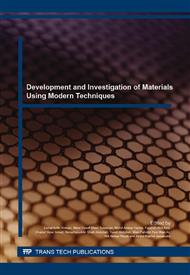p.57
p.61
p.66
p.71
p.77
p.82
p.87
p.91
p.97
Preparation and Characterization of Hydrophobic Ceramic Foam
Abstract:
Ceramic foam are a class of high porosity materials that are used for various applications. In this study, foam ceramic porcelain powder was produced by using polymeric sponge replication method at different solid content ranging from 30 to 50 wt. %. Properties of ceramic foam was characterized for porosity and density. Ceramic foam then grafted with methyltriethoxysilane (MTMS) at different concentration ranging from 0 to 9.0% v/v to determine hydrophobic effect and oil absorption capacity. From the results, it was found that the density of ceramic foam increased while porosity was decreased with increasing solid contents. It is clearly seen that, MTMS grafting contribute to hydrophobic effect of ceramic foam which enable repelling of water. The amount of oil absorbed by ceramic was found increased by increasing concentration of MTMS for all solid contents. As conclusion, MTMS give significant effects on hyrdophobic ceramic foam and produce good absorption capacity. The lower solid content produced better oil absorption compared to higher solid content due to presence of higher porosity.
Info:
Periodical:
Pages:
77-81
Citation:
Online since:
January 2016
Keywords:
Price:
Сopyright:
© 2016 Trans Tech Publications Ltd. All Rights Reserved
Share:
Citation:


